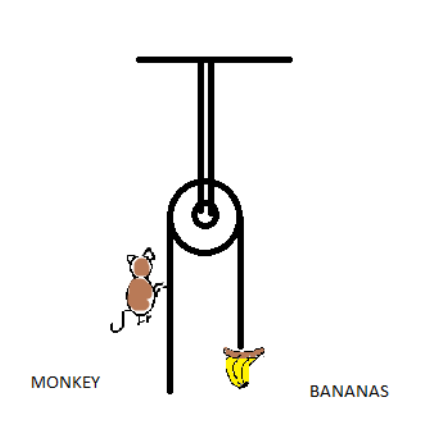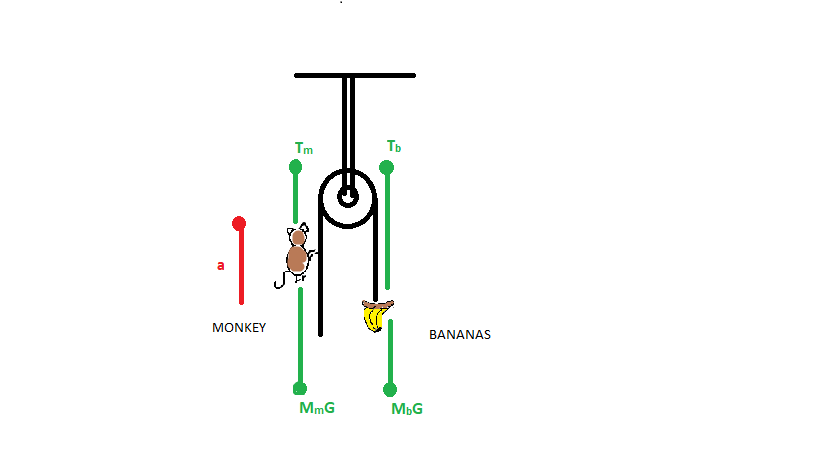
A monkey is at rest on a weightless rope which goes over a pulley and is tied to a bunch of bananas at the other end. The weight of the bunch of bananas is exactly the same as that of the monkey. The pulley is frictionless and weightless. The monkey starts to climb up the rope to reach the bananas. As he climbs, the distance between him and the bananas will:

Answer
143.4k+ views
Hint: Here, the monkey accelerates upwards, thus the bunch of bananas also accelerates with the same magnitude which is downwards. The mass of the monkey and bananas are the same. The separation between monkey and bananas remains constant. In case the monkey moves upward then
Complete step by step answer:

Let us assume that the monkey is moving upward with direction a. The forces acting on the monkey is
Similarly, the forces acting on the bananas are
So, from the above data the net force in the direction of acceleration a (for monkey) is:
The net force for bananas is
Equating both the equations,
On multiplying the term we get
According to the question, the mass of the monkey and bananas are the same.
So,
Therefore, the acceleration
Hence the correct option is
Note: In the above question, bananas are not accelerating in any direction and only the monkey is moving with an acceleration a.
Wrong thinking:
The monkey is moving up by pulling the rope downwards, then the distance between the monkey and bananas will be decreased.
The above one is wrong because the masses of the monkey and bananas are the same as per question.
Complete step by step answer:

Let us assume that the monkey is moving upward with direction a. The forces acting on the monkey is
Similarly, the forces acting on the bananas are
So, from the above data the net force in the direction of acceleration a (for monkey) is:
The net force for bananas is
Equating both the equations,
On multiplying the term we get
According to the question, the mass of the monkey and bananas are the same.
So,
Therefore, the acceleration
Hence the correct option is
Note: In the above question, bananas are not accelerating in any direction and only the monkey is moving with an acceleration a.
Wrong thinking:
The monkey is moving up by pulling the rope downwards, then the distance between the monkey and bananas will be decreased.
The above one is wrong because the masses of the monkey and bananas are the same as per question.
Latest Vedantu courses for you
Grade 11 Science PCM | CBSE | SCHOOL | English
CBSE (2025-26)
School Full course for CBSE students
₹41,848 per year
EMI starts from ₹3,487.34 per month
Recently Updated Pages
How to find Oxidation Number - Important Concepts for JEE

How Electromagnetic Waves are Formed - Important Concepts for JEE

Electrical Resistance - Important Concepts and Tips for JEE

Average Atomic Mass - Important Concepts and Tips for JEE

Chemical Equation - Important Concepts and Tips for JEE

Concept of CP and CV of Gas - Important Concepts and Tips for JEE

Trending doubts
JEE Main 2025 Session 2: Application Form (Out), Exam Dates (Released), Eligibility, & More

JEE Main Exam Marking Scheme: Detailed Breakdown of Marks and Negative Marking

JEE Main 2025: Derivation of Equation of Trajectory in Physics

Electric Field Due to Uniformly Charged Ring for JEE Main 2025 - Formula and Derivation

Degree of Dissociation and Its Formula With Solved Example for JEE

Physics Average Value and RMS Value JEE Main 2025

Other Pages
Units and Measurements Class 11 Notes: CBSE Physics Chapter 1

JEE Advanced Marks vs Ranks 2025: Understanding Category-wise Qualifying Marks and Previous Year Cut-offs

NCERT Solutions for Class 11 Physics Chapter 1 Units and Measurements

Motion in a Straight Line Class 11 Notes: CBSE Physics Chapter 2

JEE Advanced 2025: Dates, Registration, Syllabus, Eligibility Criteria and More

JEE Advanced Weightage 2025 Chapter-Wise for Physics, Maths and Chemistry




